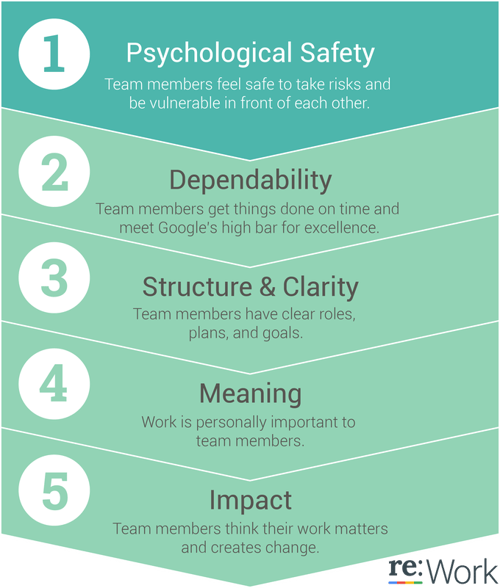
Build Psychological Safety
What is psychological safety?
Over the past few weeks, I have been traveling from state to state talking with superintendents and systems leaders about how to create a culture of innovation. One of the key themes we discuss in these conversations, workshops, and keynotes is around developing deep trust. For me, and many other leaders, deep trust is built through fostering a psychologically safe environment. Amy Edmondson, the Harvard Researcher who coined this term, defines psychological safety as “a belief that one will not be punished or humiliated for speaking up with ideas, questions, concerns, or mistakes.”
There has been a gaggle of articles about Google’s Project Aristotle, a two-year study of hundreds of Google employees to identify what makes certain teams more effective than others. The study found that the five elements visualized below were far more important than individual team members or the intelligence/pedigree of the team. Both Amy Edmondson and Google found that the teams who made more mistakes were actually more successful. “Creating an environment in which people feel comfortable to take risks is key to fostering innovative workplaces.”
Creating safety with strangers
But how quickly can you develop this sense of trust and encourage risk-taking? I led a workshop for more than 100 leaders, and a few minutes into my presentation I asked folks to shout out answers to the question, “What is innovation?” The result was radio silence. People were engaged, they weren’t deep into email and cell phones, and so I realized quickly that this was a group that either 1) was not comfortable sharing with each other or 2) was worried about being judged by me for an incorrect answer. What this group experienced was not unique. Stanford Professor Laura Delizonna explains:
“Ancient evolutionary adaptations explain why psychological safety is both fragile and vital to success in uncertain, interdependent environments. The brain processes a provocation by a boss, competitive co-worker, or dismissive subordinate as a life-or-death threat. The amygdala, the alarm bell in the brain, ignites the fight-or-flight response, hijacking higher brain centers. This ‘act first, think later’ brain structure shuts down perspective and analytical reasoning. Quite literally, just when we need it most, we lose our minds. While that fight-or-flight reaction may save us in life-or-death situations, it handicaps the strategic thinking needed in today’s workplace.”
Sensing this “fight or flight” alarm in the crowd, I tried to shift gears. Professor Barbara Fredrickson at the University of North Carolina has found that “positive emotions like trust, curiosity, confidence, and inspiration broaden the mind and help us build psychological, social, and physical resources. We become more open-minded, resilient, motivated, and persistent when we feel safe.” I started with humor, sharing a personal story from my childhood. I modeled vulnerability, revealing that I was trying a new polling tool that had I had never used before. I named the discomfort, “I won’t ask you to shout out answers for this next question.” Finally, I lowered the stakes, “For this next question, why don’t you share your thoughts just with one colleague at your table.”
The result was that at the end of thirty minutes more folks were engaged, asking questions, and talking. You could feel the culture of the room shift. But as I drove to the airport, I continued to wonder how I could have gotten us there faster, more effectively, or in a way that was lasting. The resources shared in the Use It section below are what I’m revisiting now and thinking about as I plan my next presentation.
5 keys to a successful team

Image courtesy of Google re:Work
How to build safety
If you want to start developing psychological safety on your teams, check out these resources.
- Start sharing your own mistakes – get inspiration from this excellent NY Times article, Talking About Failure Is Crucial For Growth
- Learn from research professor Brené Brown about How Vulnerability Can Make Our Lives Better
- Read these 7 tips for creating psychological safety on teams
- Explore what it takes to create a culture of innovation (hint: psychological safety and deep trust are at the core)
- Join me in conversation @kearaduggan.
This blog post was originally published on The KikiBrief.
About Keara Mascareñaz
Keara is a Managing Partner at Education Elements who focuses on how to build and scale a culture of innovation in large systems, how to create national communities of collaboration, and how to keep laughing when pursuing daunting, large-scale changes. She was lucky to collaborate with co-authors Alexis Gonzales-Black and Anthony Kim to design the website and toolkit for The NEW School Rules: 6 Practices for Responsive and Thriving Schools.




